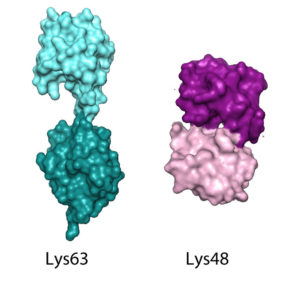Mechanisms of ubiquitination
![]() Even though ubiquitination participates in most, if not all cellular processes, many questions in the field remain unanswered. These include questions regarding the basis of the ubiquitination process. The final step is carried out by the ubiquitin ligase (E3) which guides the modification of a substrate by bringing both the E2-ubiquitin conjugate and the substrate together. One of the outstanding questions concerns the regulation of the E3 ligase activity, in particular of single-unit E3 ligases of which there are more than 540 in Arabidopsis. Many U-box type E3 ligase such as PUB22, form signalling modules with different types of kinases, including receptor and mitogen-activated protein (MAP) kinases to regulate a plethora of celluar responses ranging from immunity to development.
Even though ubiquitination participates in most, if not all cellular processes, many questions in the field remain unanswered. These include questions regarding the basis of the ubiquitination process. The final step is carried out by the ubiquitin ligase (E3) which guides the modification of a substrate by bringing both the E2-ubiquitin conjugate and the substrate together. One of the outstanding questions concerns the regulation of the E3 ligase activity, in particular of single-unit E3 ligases of which there are more than 540 in Arabidopsis. Many U-box type E3 ligase such as PUB22, form signalling modules with different types of kinases, including receptor and mitogen-activated protein (MAP) kinases to regulate a plethora of celluar responses ranging from immunity to development.
 It remains largely unknown which type of ubiquitin chains are built by specific E2 ubiquitin-conjugating enzymes (e.g. Lys63 or Lys48-linked chains). Ubiquitin is linked in different ways constituting the ubiquitin code, and determining the different fates of the modified protein, such as degradation or subcellular relocalization. The type of chain is largely determined by the E2 ubiquitin-conjugating enzymes. To uncover the biochemical activity of E3 ligases we have developed tools to identify physiological E2-E3 pairs and characterize their activities.
It remains largely unknown which type of ubiquitin chains are built by specific E2 ubiquitin-conjugating enzymes (e.g. Lys63 or Lys48-linked chains). Ubiquitin is linked in different ways constituting the ubiquitin code, and determining the different fates of the modified protein, such as degradation or subcellular relocalization. The type of chain is largely determined by the E2 ubiquitin-conjugating enzymes. To uncover the biochemical activity of E3 ligases we have developed tools to identify physiological E2-E3 pairs and characterize their activities.